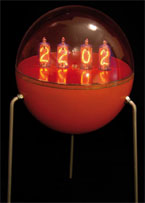Sputnik Time Machine
Nostalgia and microcontroller technology merged in a single design

Sputnik 1, the first artificial satellite, was launched in 1957. It captured the attention of the entire world with the eerie beeps it transmitted, which could be received by radio amateurs everywhere in the world. Fifty years after this historic event, it seems fitting to build a clock in the shape of the Sputnik satellite that combines a nostalgic Nixie tube display with a modern microcontroller.
Technology has changed a lot in recent decades. Launching a satellite that simply transmitted a beep signal was a major achievement in 1957, but now we routinely put satellites into orbit that can transmit hundreds of television channels.
This design uses a combination of modern and old-fashioned technology. The shape of the Sputnik and the Nixie tubes are elements of old-fashioned technology, while the low-loss switching regulators for the supply voltages and the microcontroller-based control logic are examples of modern technology.
This is a MEMBER ONLY article. You need a subscription to read this article.
- Unlimited access to online Member Only articles
- 3 new editions Elektor Magazine (digital)
- More than 5000 Gerber files
- 20% member discount on e-books (at elektor.com)
- 10% member discount on Products (at elektor.com)
Available from €5.33 per month.
What is Members Only
Elektor is committed to providing high-quality content on electronics, catering to tens of thousands of paying members. As part of this commitment, Elektor has launched Premium, an initiative that offers exclusive online articles to members sometimes even before they appear in the magazine.
Every day, members can access in-depth articles that showcase the best of Elektor's premium content.
This initiative aims to reward members with early access. Once logged in, members can easily enjoy this exclusive content and engage in discussions about featured projects. While Premium adds to the existing resources available, Elektor will continue to provide a wealth of free information.
Join the Elektor community today to take advantage of Premium and other benefits!
Materials
Gerber file
CAM/CAD data for the PCB referred to in this article is available as a Gerber file. Elektor GREEN and GOLD members can exclusively download these files for free as part of their membership. Gerber files allow a PCB to be produced on an appropriate device available locally, or through an online PCB manufacturing service.
Elektor recommends the Elektor PCB Service service from its business partner Eurocircuits or AISLER as the best services for its own prototypes and volume production.
The use of our Gerber files is provided under a modified Creative Commons license. Creative Commons offers authors, scientists, educators and other creatives the freedom to handle their copyright in a more free way without losing their ownership.
Extra info / Update
Component list
Resistors
R1,R2,R3,R4 = 15k
R5 = 100k
R6 = 750k
R7 = 5k6
R8 = 150
R9,R13,R14 = 10k
R10 = 68k
R11 = 22k
R12 = 1
Capacitors
C1 = 1000µF 25V
C2 = 470pF
C3 = 100nF
C4 = 470µF 16V
C5 = 470pF
C6 = 100nF
C7 = 100nF
C8 = 4.7µF 400V
C9 = 100nF
C10,C11 = 33pF
C12 = 10µF
Inductors
L1,L2 = 330µH
Semiconductors
D1,D2,D3,D4 = 1N4003
D5 = 1N5819
D6 = BYV26C
T1 = IRF820
T2,T3 = MPSA42
IC1 = 89C2051, programmed, order code 050018-41
IC2,IC3,IC4 = 74141
IC5,IC6 = MC34063
Miscellaneous
Q1 = 12.000MHz quartz crystal
AN1,AN2,AN3,AN4 = ZM1332
IC sockets: 2 off DIL 8-pin; 3 off DIL 16-pin; 1 off DIL 20-pin
PCB, ref. 050018-1 from ThePCBShop
Source and hex code files, free download



Discussion (0 comments)